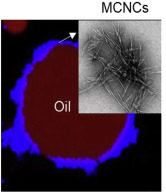New Food Hydrocolloids paper published on Pickering emulsions using cellulose nanocrystals

Huge Congratulations to Hoang Du Le, our Visiting PhD Student from Massey University, New Zealand for publishing his work on Pickering emulsions in Food Hydrococolloids. Cellulose nanocrystals (CNCs) esterified with octenyl succinic anhydride (OSA) acted as the Pickering stabilizers, the particles were characterized using Fourier transform infrared (FTIR) spectroscopy, X-ray diffractometry (XRD), transmission electron microscopy (TEM) and wettability analysis. The stability of the Pickering O/W emulsions (20 wt% oil, 0.05–1.00 wt% MCNCs) was assessed using droplet sizing, microscopy, ζ-potential, apparent viscosity and oscillatory rheological measurements. Hydrophobic modification of CNCs with OSA was evidenced by an increase in static water contact angle from 56° (untreated CNCs) to 80.2° (MCNCs) which allowed the MCNCs to be partially wetted by both the phases and stabilise O/W emulsions. The Pickering emulsions showed droplet flocculation at pH < 4.0 (without addition of NaCl) or ionic strength ≥ 20 mM NaCl (pH 7.0), with a predominant elastic gel-like behaviour observed at ≥ 20 mM NaCl. These aggregated emulsions at low pH and high ionic strength responded differently under shearing conditions; in particular, emulsions at higher ionic strength (≥20 mM NaCl) had a prominent gel-like character. Nevertheless, the emulsions were strongly resistant to coalescence under all pH and ionic strength conditions investigated, which might be associated with the formation of a thick and dense layer of MCNCs around the oil droplets as well as with the MCNCs in the bulk phase forming strong bridges with the MCNCs at the interface, resulting in a gel-like network that reduced the mobility of the droplets. Such unique responsiveness of MCNCs to elastic gel formation at acidic pH and in the presence of ions might be applied in the design of emulsion systems to target the delivery of bioactive compounds. Click here to read the Food Hydrocolloids paper, Volume 99, 2020, 105292: https://doi.org/10.1016/j.foodhyd.2019.105344

